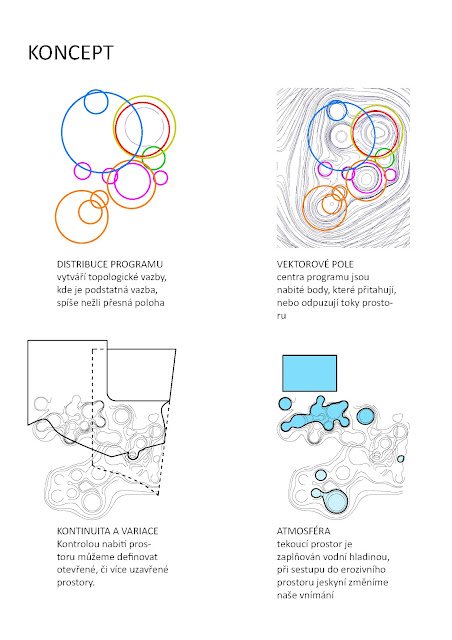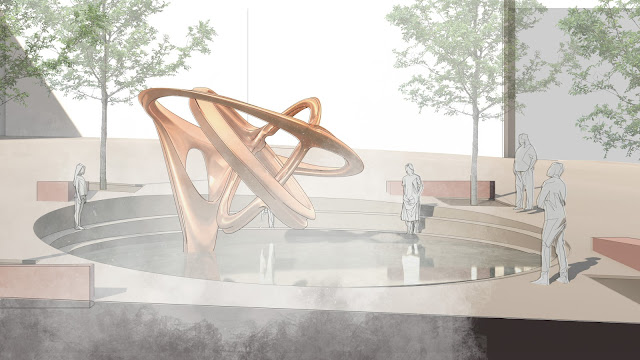V počátku návrhu byl důležitý důkladný výzkum a zhodnocení dlouhodobého zájmu o santiniho architekturu.
Santini nám ve Žďáře nabízí 3 základní hypotézy: světlo, diagram a syntéza jazyků.
hmota je zhuštěné světlo, neboli hmotu nadnáší duch: dematerializace v architektuře.
U Santiniho je otázka světla zásadní, stejně jako Kahn, měl tendenci vytvářet stavby s minimalizovaným vnitřním stínem. Distribuuje světlo tak, že se interier stavby zdá nesen světlem. Viz situace v hlavním prostoru Zelené Hory, kdy tam kde bychom očekávali nosné pilíře jsou světelné otvory. Svého Mistrovství Santini dosahuje tím, že je sochařský architekt, tedy projekt vytváří pomocí modelu, spíše než pomocí sady výkresů. Kontroluje tím distribuci světla a je tak schopen vizualizovat složité geometrie, které v té době byli jen velmi obtížně anotovatelné. Proto také používá notně bílé interiéry nezdobené zlatem jak bylo v baroku běžné.
Diagram- Idea : Santini pracuje s diagramem, který je nosným libretem - ideou. Ten se stává generativním nástrojem. Díky tomu dosahuje komplexního a originálního vnitřního prostoru. I Díky práci s diagramem dochází k syntéze jazyků baroka a gotiky a vytváří tím svůj vlastní osobitý jazyk architektury. Při hlubším studiu forem je patrná důležitost ostré hrany, stěny jsou fragmentovány do konvexně konkávních křivek, které ale nejsou plynulé, ale mají ostré přechody, tak aby vznikl hrot, nebo dynamika římsy. Tyto zjištění pak byli zásadní pro návrh Informačního turistického centra.
Při úvahách jak se vyrovnat s problémem souboje nové a staré architektury, či případně ega architektů a stávajícího kostela s ambitem, jsme dospěli k názoru, že je třeba v Díle Jana Blažeje Santiniho a Václava Vejmluvy pokračovat. Pro toto rozhodnutí jsme nalezli argument v interiéru kostela/1/, kde od zaklenutí bočních oltářů vybíhají žebra, která jsou useknuta v prostoru. Jsou proto dvě vysvětlení : jedno, že se tím referencuje boční oltář k celku hlavní lodi /vztah částí a celku / a druhý, že téma katedrály je v kontinuitě. Žádná generace nemůže celou stavbu dokončit a tak je na generaci následující aby pokračovala, tzv. osedlávání kobyle.
Vlastní oproštění od ega probíhá v osedlání diagramu ambitu kostela a jeho regenerování pro místo ITC. Dochází tak k tomu ,že hroty ambitu pokračují ve svém směrování a kontextualizací v krajině a nová stavba se tak stává celkem. Půdorysná stopa tedy sleduje diagram santiniho, zatímco řezové stopy trasují morfologii terénu. Další výhoda diagramatického navrhování je, že se dá s projektem v dalších fázích pracovat, aniž by zmizela idea, nebo princip projektu.
Program : zadání chápeme jako dva hlavní programy, jeden jako galerie ( soch případě modelů a prezentace santiniho díla ( v dnešní době jsou schémata a výkresy položeny na židly v kostele ) ) a druhý jako turistické informační centrum, kde si návštěvník koupí lístek, suvenýr, skočí si na toaletu a jde na prohlídku. V tomto pojetí je půdorysný tvar vhodný, každá socha je umístěna do svého dominantního prostoru ( zvyšující se stropy ) a osvětlení shora. Dispozice je organizována jako volný střed s extenzí do vrcholů trojúhelníku a obslužné prostory jsou integrovány do hmoty zdí. Nejde tedy primárně o dělení prostoru, ale spíše o jeho zahloubení a integrování. Proto jsou i různé místnosti artikulovány s takovou mírou detailů ,aby bylo jasné zdali je to sklad nebo kancelář, apod.
Závěrem : Je to skvělá příležitost pro Žďár najít nový směr a využít svůj potenciál, nevěříme, že ITC je o utilitární generické stavbě, ale naopak kobyla musí být osedlána.
At the beginning of the design process, it was important to conduct thorough research and evaluate the long-standing interest in Santini's architecture.
Santini offers us 3 basic hypotheses in Žďár: light, diagram, and synthesis of languages.
The matter is condensed light, or matter is superimposed by the spirit: dematerialization in architecture.
For Santini, the question of light is fundamental; like Kahn, he tended to create buildings with minimized internal shadow. He distributes light in such a way that the interior of the building appears to be carried by light. See the situation in the main space of Green Mountain, where we would expect load-bearing pillars there are light openings. Santini achieves his mastery by being a sculptural architect, that is, he creates the project using a model rather than a set of drawings. By doing so, he controls the distribution of light and is able to visualize complex geometries that at the time were very difficult to annotate. This is also why he uses notable white interiors not decorated with gold as was common in the Baroque.
Diagram- Idea: Santini works with a diagram, which is the supporting libretto - the idea. This becomes a generative tool. Thanks to this he achieves a complex and original interior space. Also by working with the diagram, he synthesizes the languages of Baroque and Gothic, creating his own distinctive language of architecture. A deeper study of the forms reveals the importance of sharp edges; the walls are fragmented into convex-concave curves, which are not continuous but have sharp transitions so as to create a spike or the dynamics of a cornice. These findings were then fundamental to the design of the Tourist Information Centre.
In considering how to deal with the problem of the duel between new and old architecture, or possibly the egos of architects and the existing church with its ambit, we have come to the conclusion that the work of Jan Blazej Santini and Václav Vejmluva must be continued. We found an argument for this decision in the interior of the church/1/, where ribs protrude from the arches of the side altars and are cut off in space. There are therefore two explanations: one that this refers to the side altar to the whole of the nave /the relationship of the parts and the whole/ and the other that the theme of the cathedral is in continuity. No one generation can complete the whole building and so it is up to the next generation to continue, the so-called saddling of the mare.
The actual liberation from ego takes place in the saddling of the diagram of the church's ambite and its regeneration for the ITC site. Thus the spikes of the ambit continue their direction and contextualization in the landscape and the new building becomes whole. The plan trace thus follows the Santini diagram, while the section traces trace the morphology of the terrain. Another advantage of the diagrammatic design is that one can work with the project in subsequent phases without losing the idea or principle of the project.
Program: we understand the assignment as two main programs, one as a gallery ( sculpture case models and presentations of Santini's work ( nowadays diagrams and drawings are put on chairs in the church ) ) and the other as a tourist information center where the visitor buys a ticket, a souvenir, hops into the restroom and goes for a tour. In this concept, the plan form is appropriate, each statue is placed in its own dominant space ( rising ceilings ) and illuminated from above. The layout is organized as a loose center with extensions to the vertices of the triangle and the service spaces are integrated into the mass of the walls. It is therefore not primarily about dividing the space, but rather about deepening and integrating it. This is why the different rooms are articulated in such detail that it is clear whether it is a warehouse or an office, etc.
Conclusion: This is a great opportunity for Zdar to find a new direction and realize its potential, we don't believe ITC is about utilitarian generic building, but instead the mare must be saddled.












































